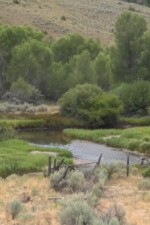Welcome to Tanner’s Ford Valley
Tanner’s Ford Valley consists of nine ranches, most of which were established in the 1870’s. The first two families, the MacDougals and Elliotts, each had six sons and a daughter. These descendents are the heroes and heroines of the first four books in the Bride Train series.
The Valley is located between the Beaverhead and Bitterroot National Forests in southeast Montana. Bannack City was, and is, real, though now it’s a state park filled with homes and businesses dating from the 1860s gold fever era.
Times were tough in those days, and the people had to be the same to survive. The men who came west in the late 1860s were seeking a new future. Many thought the prospect of finding gold would satisfy them, others decided to make their fortune off those seeking gold. A few, such as the ranchers in Tanner’s Ford, wanted land of their own.
Back east in the States (Montana was only a Territory) the government wanted the land settled and claimed. So many single men had done West to seek their fortune that there weren’t enough bachelors to fulfill the marriage dreams of Eastern women.
The few marriageable women who came west found themselves surrounded by hundreds of single men. They were usually well treated, distinguished as ladies in comparison to the “soiled doves” who wanted a man’s gold dust rather than a gold ring on her finger. Mail-order brides were one way to populate the new Territory, but there needed to be something more.
The idea was born of having a number of Bride Trains carry spinsters, widows, and other females who were not likely to find a husband in the East. They would be provided transportation in return for finding a husband, settling down, and raising children to populate the vast tracts of land.
The women who chose to ride the Bride Train did so for many reasons. They were over 21, and therefore too old to find a husband. They did not like the man their fathers chose for them, or were widows. Jobs were few after the end of the War, and women had few options. If they didn’t marry they could work long hours as a servant, find pittance work as a seamstress or the like, or they could sell their body.
Far better to travel West and seek adventure.
Strong-minded, intelligent, educated, and determined, women boarded the Bride Trains each spring, summer, and autumn. Most found husbands along the way, as they eager bachelors flocked to the railway stations to greet them.
The women who made it all the way to the end of the line in Virginia City, Montana Territory, were the most uppity. These feisty gals are the heroines in the Bride Train series: Beth, Amelia, Jessie, Florence, Victoria, Sarah, Kate, Casey, and Sophie.
Each of them discovers a life quite different from what they imagined when they boarded the Bride Train. Yes, the land is beautiful and wild. Yes, the work is hard. The summer’s heat at 5,000 feet altitude burns them, the spring and autumn rains bog them down, and the dark winter’s cold freezes them. There are wild animals, rattlers, fire, flood, disease, and any number of potential catastrophes. This was usually expected.
What they did not expect was sharing their lives with three husbands, rather than one.

